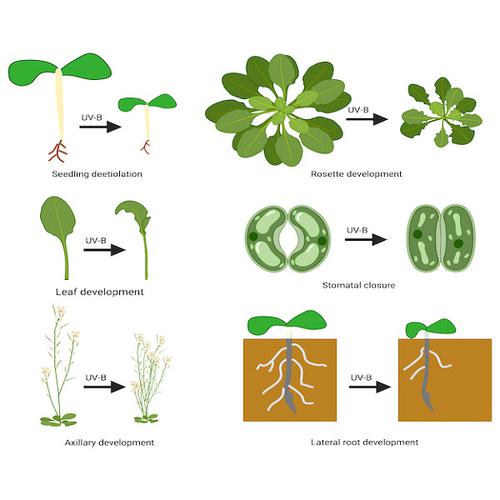当前位置:
X-MOL 学术
›
J. Integr. Plant Biol.
›
论文详情
Our official English website, www.x-mol.net, welcomes your
feedback! (Note: you will need to create a separate account there.)
Light signaling and UV-B-mediated plant growth regulation.
Journal of Integrative Plant Biology ( IF 9.3 ) Pub Date : 2020-05-15 , DOI: 10.1111/jipb.12932 Arpita Yadav 1 , Deeksha Singh 1 , Maneesh Lingwan 2 , Premachandran Yadukrishnan 1 , Shyam Kumar Masakapalli 2 , Sourav Datta 1
Journal of Integrative Plant Biology ( IF 9.3 ) Pub Date : 2020-05-15 , DOI: 10.1111/jipb.12932 Arpita Yadav 1 , Deeksha Singh 1 , Maneesh Lingwan 2 , Premachandran Yadukrishnan 1 , Shyam Kumar Masakapalli 2 , Sourav Datta 1
Affiliation

|
Light plays an important role in plants’ growth and development throughout their life cycle. Plants alter their morphological features in response to light cues of varying intensity and quality. Dedicated photoreceptors help plants to perceive light signals of different wavelengths. Activated photoreceptors stimulate the downstream signaling cascades that lead to extensive gene expression changes responsible for physiological and developmental responses. Proteins such as ELONGATED HYPOCOTYL5 (HY5) and CONSTITUTIVELY PHOTOMORPHOGENIC 1 (COP1) act as important factors which modulate light‐regulated gene expression, especially during seedling development. These factors function as central regulatory intermediates not only in red, far‐red, and blue light pathways but also in the UV‐B signaling pathway. UV‐B radiation makes up only a minor fraction of sunlight, yet it imparts many positive and negative effects on plant growth. Studies on UV‐B perception, signaling, and response in plants has considerably surged in recent times. Plants have developed different strategies to use UV‐B as a developmental cue as well as to withstand high doses of UV‐B radiation. Plants’ responses to UV‐B are an integration of its cross‐talks with both environmental factors and phytohormones. This review outlines the current developments in light signaling with a major focus on UV‐B‐mediated plant growth regulation.
中文翻译:

光信号和UV-B介导的植物生长调节。
光线在植物的整个生命周期中都起着重要的作用。植物响应强度和质量变化的光照提示而改变其形态特征。专用的感光器可帮助植物感知不同波长的光信号。活化的光感受器刺激下游信号传导级联反应,从而导致负责生理和发育反应的大量基因表达变化。ELONGATED HYPOCOTYL5(HY5)和组成型光生性蛋白1(COP1)等蛋白质是调节光调节基因表达的重要因素,尤其是在幼苗发育过程中。这些因素不仅在红,远红和蓝光途径中而且在UV-B信号途径中均作为中央调节中间体。UV-B辐射仅占阳光的一小部分,但对植物生长却产生了许多正面和负面影响。近年来,有关植物中UV-B感知,信号传导和反应的研究激增。植物已经开发出不同的策略来将UV-B用作发育线索并承受高剂量的UV-B辐射。植物对UV-B的反应是其串扰与环境因素和植物激素的综合。这篇综述概述了光信号的最新发展,重点是UV-B介导的植物生长调节。植物已经开发出不同的策略来将UV-B用作发育线索并承受高剂量的UV-B辐射。植物对UV-B的反应是其串扰与环境因素和植物激素的综合。这篇综述概述了光信号的最新发展,重点是UV-B介导的植物生长调节。植物已经开发出不同的策略来将UV-B用作发育线索并承受高剂量的UV-B辐射。植物对UV-B的反应是其串扰与环境因素和植物激素的综合。这篇综述概述了光信号的最新发展,重点是UV-B介导的植物生长调节。
更新日期:2020-05-15
中文翻译:

光信号和UV-B介导的植物生长调节。
光线在植物的整个生命周期中都起着重要的作用。植物响应强度和质量变化的光照提示而改变其形态特征。专用的感光器可帮助植物感知不同波长的光信号。活化的光感受器刺激下游信号传导级联反应,从而导致负责生理和发育反应的大量基因表达变化。ELONGATED HYPOCOTYL5(HY5)和组成型光生性蛋白1(COP1)等蛋白质是调节光调节基因表达的重要因素,尤其是在幼苗发育过程中。这些因素不仅在红,远红和蓝光途径中而且在UV-B信号途径中均作为中央调节中间体。UV-B辐射仅占阳光的一小部分,但对植物生长却产生了许多正面和负面影响。近年来,有关植物中UV-B感知,信号传导和反应的研究激增。植物已经开发出不同的策略来将UV-B用作发育线索并承受高剂量的UV-B辐射。植物对UV-B的反应是其串扰与环境因素和植物激素的综合。这篇综述概述了光信号的最新发展,重点是UV-B介导的植物生长调节。植物已经开发出不同的策略来将UV-B用作发育线索并承受高剂量的UV-B辐射。植物对UV-B的反应是其串扰与环境因素和植物激素的综合。这篇综述概述了光信号的最新发展,重点是UV-B介导的植物生长调节。植物已经开发出不同的策略来将UV-B用作发育线索并承受高剂量的UV-B辐射。植物对UV-B的反应是其串扰与环境因素和植物激素的综合。这篇综述概述了光信号的最新发展,重点是UV-B介导的植物生长调节。











































 京公网安备 11010802027423号
京公网安备 11010802027423号